Falls happen more than most of us realize, affecting about three million older people each year and resulting in over 800,000 hospitalizations (1) and roughly 38,000 deaths annually. (2) They’re among the most common and debilitating issues older adults face. (3) Fall detection devices, such as medical alert systems, provide the user and their caregivers security. (4)
“Fall detection devices are essential in providing peace of mind to both the user and their caregivers. These devices can promptly alert emergency services and loved ones in the event of a fall, ensuring timely medical intervention and reducing the risk of long-term consequences.”
—Dr. Raj Dasgupta, MD, FACP, FCCP, FAASM, medical reviewer
Reliability and rapid response times are paramount when it comes to fall detection devices. That’s why our team at Fortune Recommends has rigorously evaluated dozens of these devices to identify the top performers for seniors and their loved ones.
To determine the best fall detection devices on the market, we subjected each device to a series of real-world scenarios and emergency simulations, meticulously assessing their performance in key areas such as reliability, response times, and overall user experience. After more than 500 hours of testing, we narrowed the list to the top six devices that consistently demonstrated excellence across all our evaluation criteria.
Editor’s choice
The Bay Alarm Medical SOS Home is our top pick for the best fall detection devices because it’s a reliable, user-friendly medical alert system ideal for seniors. It features fast and sensitive fall detection, responsive support, and verbal prompts for actions like charging and low battery alerts. It connects quickly to a professional monitoring center with clear two-way audio, and offers flexibility with landline and 4G LTE options, plus a 32-hour backup battery for power outages.
Our picks for the best fall detection devices
- Best variety: Bay Alarm Medical SOS Home
- Best response time: Medical Guardian MGMini
- Best for couples: MobileHelp Mobile Duo Bundle
- Best for customer-friendly policies: ADT Medical Alert Plus
- Best for observed range: Medical Guardian MGHome Cellular
- Best battery life: LifeFone VIP Active
Compare fall detection devices
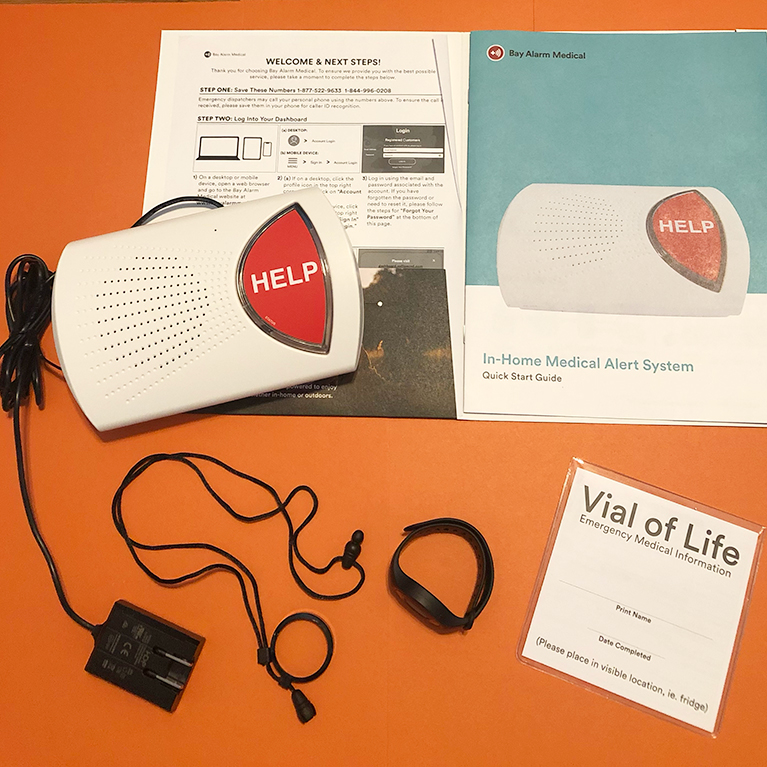
|
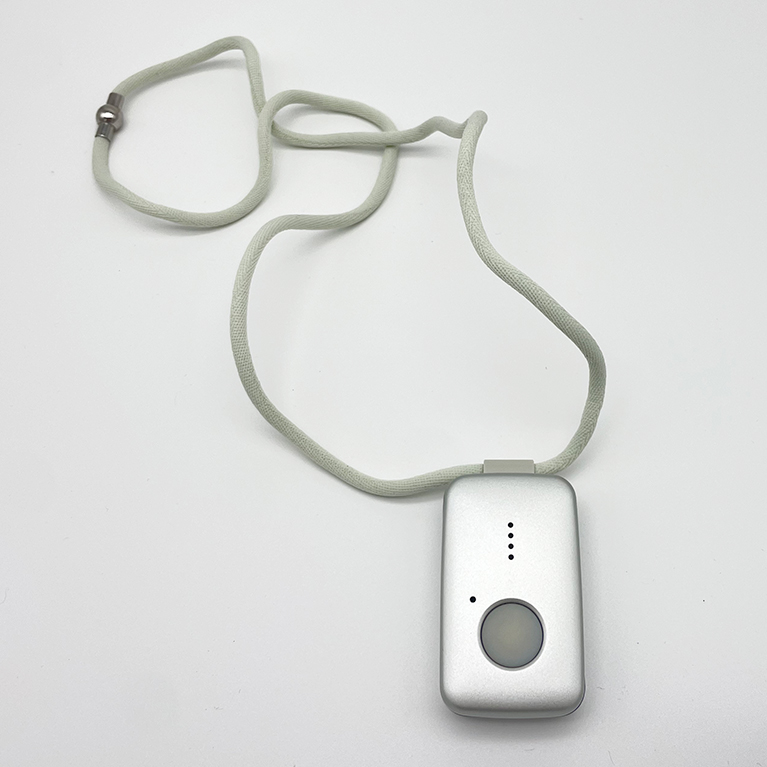
|
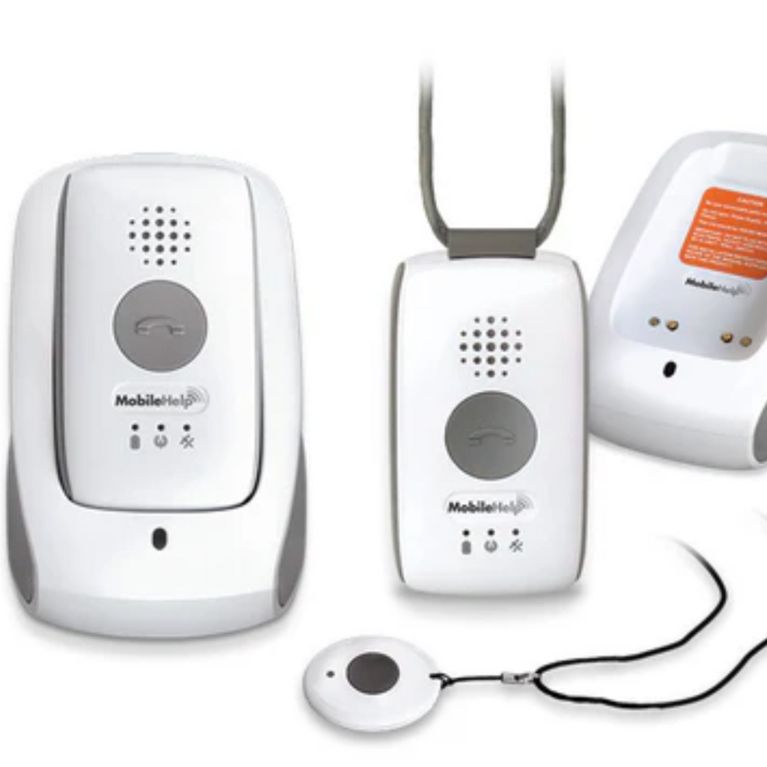
|
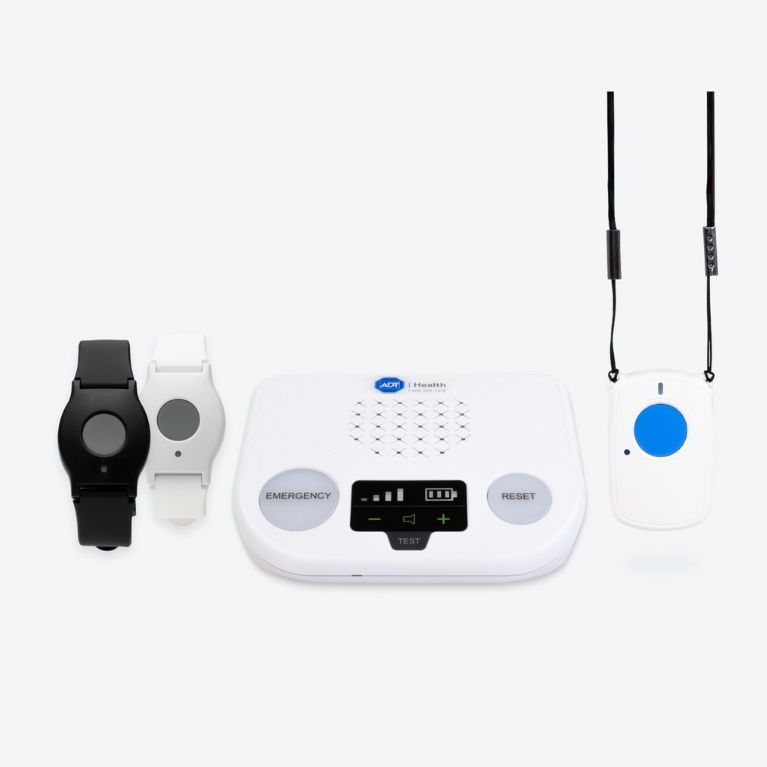
|
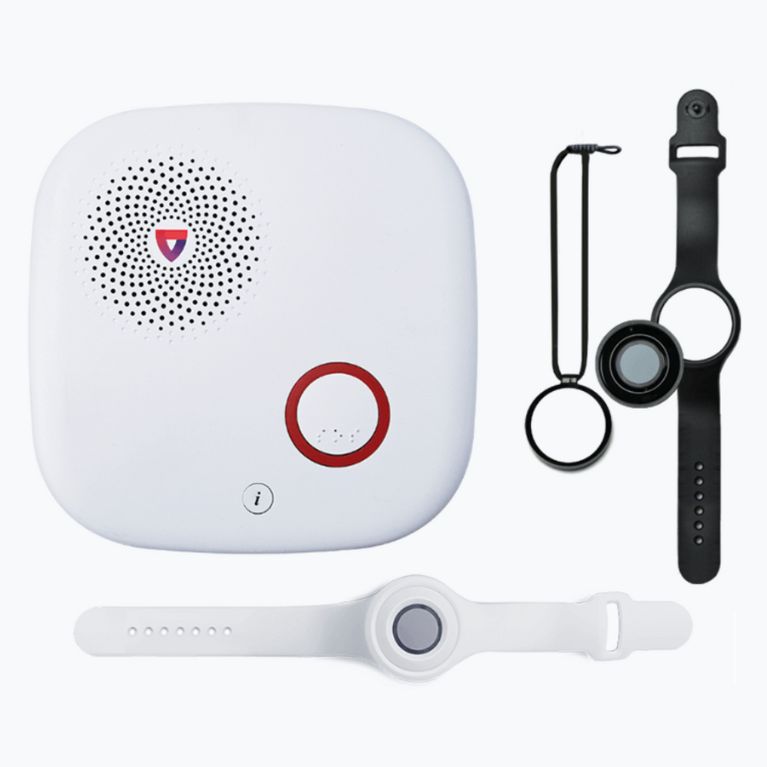
|
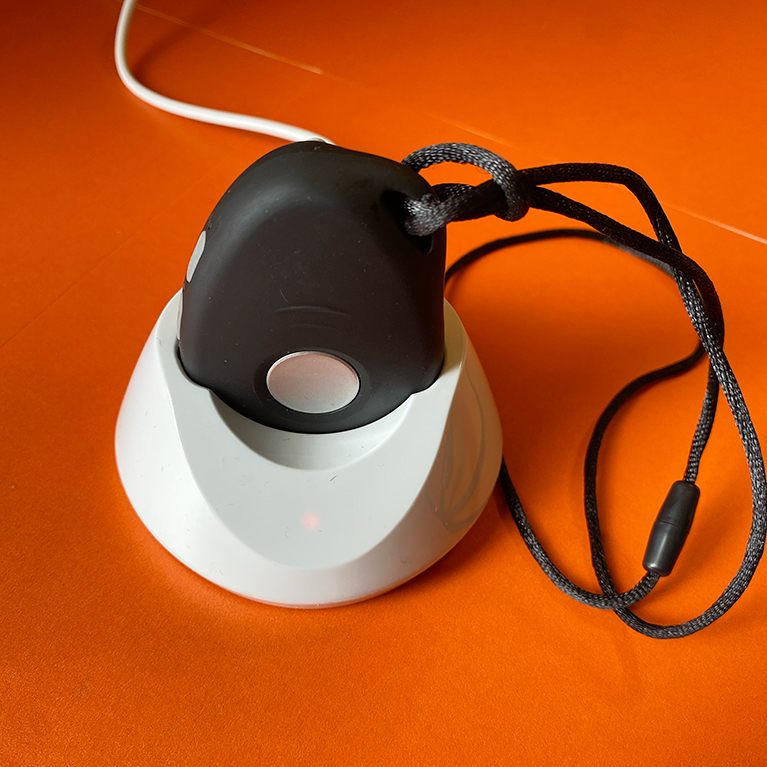
|
|
| Bay Alarm Medical SOS Home | Medical Guardian MGMini | MobileHelp Mobile Duo Bundle | ADT Medical Alert Plus | Medical Guardian MGHome Cellular | LifeFone VIP Active | |
| Rating | ||||||
| Price | $39.95/month | $39.95/month | $49.95/month | $39.99/month | $37.95/month | $41.95/month |
| Response time | 7-36 seconds | 18-30 seconds | 38-42 seconds | 60 seconds | 21-41 seconds | 17-39 seconds |
| Battery life | 32-hour backup | 5+ days | 24 hours | 24-hour backup | 32-hour backup | Up to 5 days |
| Range | 1,000 feet | Nationwide within AT&T Network | Nationwide within AT&T Network | 600 feet | 1,400 feet | Nationwide within AT&T or Verizon network |
Best fall detection device for variety: Bay Alarm Medical SOS Home
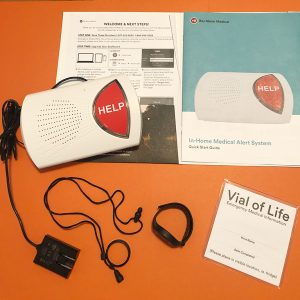

Key product features
What you should know
Bay Alarm Medical’s SOS Home system offers effective fall detection with various add-on services and products.
- Through our testing, we found the Bay Alarm Medical SOS Home device regularly detected falls.
- Modest $24.95 monthly subscription for the landline option, but fall detection requires a one-time $30 equipment fee and an additional $10/month charge for fall detection. The LTE cellular connection option is a costlier $39.95 per month.
- Good for individuals who prefer using a landline.
- U.S.-based monitoring service.
- No charges for false alarms.
Why we like Bay Alarm Medical SOS Home as best variety
The Bay Alarm Medical SOS Home is a versatile and user-friendly medical alert system that surprised us with its fast and sensitive fall detection, clear instructions, and thoughtful features. During our testing, we were pleased to find that the device provided verbal confirmations for various actions, such as when it was placed in the charging cradle or when the battery was low. The instructions were comprehensive and easy to follow, covering everything from cleaning the device to transitioning between the lanyard and belt clip.
One of the attractive features of the SOS Home is its fall detection capabilities. In our tests, the device consistently registered falls within just a few seconds, providing verbal cues and quickly connecting to the monitoring center. The agents at the monitoring center were professional and attentive, always asking to verify the user’s name to ensure they were speaking with the right person. While the audio quality was slightly tinny, it was still easily understandable, and the sensitive microphone allowed for clear two-way communication from up to two feet away.
The SOS Home is lightweight and comfortable to wear, with a magnetic clasp that makes it easy to put on and take off. However, the comfort level may depend on the user’s torso length, as the lanyard is not adjustable. This could be an issue for some users who find the device resting uncomfortably on their chest.
Regarding connectivity, the SOS Home offers flexibility by allowing users to choose between a traditional landline or a wireless 4G LTE cellular network. This means that even if you don’t have a landline or are not an existing customer of a cellular provider, you can still benefit from the device’s protection. The system also boasts a 32-hour backup battery, ensuring it will continue functioning during power outages. Additionally, the SOS Home can be easily taken with you when traveling, providing protection wherever you go.
For more information about this fall detection device, check out our full Bay Alarm Medical review.
What customers are saying
Overall, customers are pleased with the customer service, but some have found the equipment to be bothersome at times.
“We purchased the SOS Mobile personal medical alarm and added fall detection for our 92-year-old father. It is so simple to use, and he has no problem. He keeps the charger at the bedside, so the device is within reach all night and fully charged all day. Also, Bay Alarm Medical responds immediately when he tests his device, which is comforting.”
—Karin, Trustpilot
“[I] haven’t used the unit because we received the wrong unit, but [I] called, and it was a very great experience,” writes Cindy on Trustpilot. “He was very informative, answered any questions, and was very polite. Thank you for all your help; so much appreciated.”
However, some users had issues with the device itself.“Excellent technical and customer service, but inferior hardware,” writes Scott on Trustpilot. “All of my interactions with the Bay Alarm Medical team were outstanding. High quality for tech support, customer service, and the emergency response team. However, the call box has to be reset after an outbound call. The reset button is tiny and on the back side of the device. Far less than ideal for a very old person to find and press.”
Specs
| Response time | 7-36 seconds |
| In-home range | 1,000 feet |
| Battery life | 32-hour backup battery |
| Starting monthly fee | $24.95 for landline; $39.95 for cellular |
| Fall detection cost | One-time $30 equipment fee + additional $10/month |
Best response time fall detection device: Medical Guardian MGMini
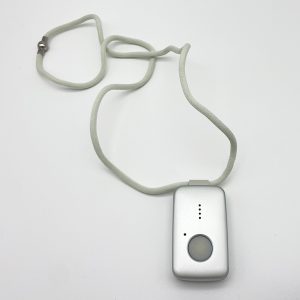

Key product features
What you should know
We’re impressed with the Medical Guardian MGMini for many reasons: its small, discreet size, its fast response, and its long battery life, to name a few.
- The device recognized falls and alerted the call center quickly; operators also responded hastily.
- $39.95 monthly subscription, but also requires a one-time $149.95 equipment and $12.50 shipping fee.
- Fall detection is not standard but is available for an additional $10/month.
- Caregiver tracking is included with hourly location updates via AT&T 4G LTE.
Why we like Medical Guardian MGMini as best response time
The Medical Guardian MGMini is a top-performing medical alert system that impressed us with its sensitive fall detection, rapid response times, and user-friendly features. During our testing, we found the setup process simple and intuitive, with clear numbered instructions and verbal confirmations guiding us through each step. The device is compact and lightweight, making it easy to wear as a medical alert necklace throughout the day without drawing attention.
One of the standout features of the MGMini is its fall detection capabilities. Our tests revealed that the device could detect both slow and hard, fast falls, with response times ranging from 18 to 30 seconds. The monitoring center agents were friendly and professional, always confirming the user’s name and promptly providing assistance. We were particularly impressed with the device’s ability to accurately track our location using GPS, (5) ensuring that help could arrive at the right place when needed.
The MGMini’s companion app is another strong point, offering a range of useful features for both users and caregivers. Caregivers can access real-time location data, set task and medication reminders, and view detailed health information about the user. The app allows easy communication between the user, caregivers, and the monitoring center. However, we were disappointed to learn that some features, such as OnGuard Alerts, come at an additional cost, even if it’s just $2.99 monthly.
While the MGMini has many positive attributes, there are a few areas where it could be improved. The light indicators on the device can be confusing, with the red light (signaling a low battery) flashing alongside the blue light, even when the device is fully charged. The fall detection feature may also be too sensitive, as it was triggered when we were simply fidgeting with the device. Despite these minor drawbacks, the Medical Guardian MGMini is an excellent choice for those seeking a reliable, feature-rich medical alert system with sensitive fall detection capabilities.
To learn more about this brand, visit our full Medical Guardian review.
What customers are saying
Overall, customers are satisfied with their Medical Guardian MGMini; however, some say they have difficulty discontinuing their service.
“They stand ready,” says George F. on Trustpilot. “Billing is simple. This is insurance that brings peace of mind. Fortunately, my wife has not had a fall, but it is nice knowing Medical Guardian is there if needed.”
“My mom is 96, and she cannot hear. Usually, someone is with her at all times, but she hits the button when she goes to her room or the restroom. I respond quickly and the operators are so nice. If I am home for a while, they will contact me right away. Both mom and I feel protected.”
—Cindy M., Trustpilot
Some users have mentioned difficulty in canceling the service and receiving refunds.
“My mom canceled her service in July,” says user “Skygirl” on Trustpilot. “She sent in all the requested paperwork. Multiple times, they said they never received it. Finally, they sent her a package to return the necklace. She never received her refund.”
Specs
| Response time | 18-30 seconds |
| In-home range | Nationwide |
| Battery life | Five-plus days |
| Starting monthly fee | $39.95, plus a one-time $149.95 equipment fee and $12.50 shipping |
| Fall detection cost | Additional $10/month |
Best fall detection device for couples: MobileHelp Mobile Duo Bundle
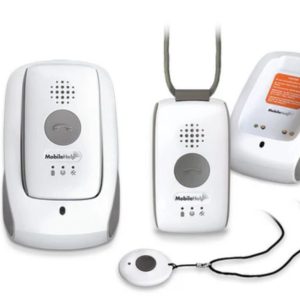

Key product features
What you should know
Since the MobileHelp Mobile Duo Bundle comes with two help buttons, it’s a smart choice for couples looking for support in case of emergencies.
- We found the MobileHelp Mobile Duo Bundle easy to set up. The machine is intuitive, and the response is fast.
- Monthly fees are higher at $24.95, but there’s no activation or equipment fee.
- Fall detection costs an additional $11/month.
- Two help buttons in one package.
Why we like MobileHelp Mobile Duo Bundle as best for couples
The MobileHelp Mobile Duo Bundle is a uniquely smart product in the medical alert system market. It provides a bundled GPS solution for two users at an affordable price (6), making it an attractive option for couples or roommates who want the comfort that comes with a mobile medical alert device. The system includes two help buttons with water-repellent technology, allowing users to wear them in the shower or during other activities where they may be exposed to moisture.
During our testing, we found the setup process straightforward, with clear pairing instructions for connecting both help buttons to the main mobile device. However, the mobile device requires a separate pendant for fall detection, which adds an extra step to the setup process. The fall detection feature was consistent and reliable, with response times ranging from 38 to 42 seconds for the call and just six seconds for the connection to the operator.
One area where the Mobile Duo could improve is the design of the mobile device itself. The power and test buttons on the side of the device were difficult to press, making it hard to tell if we were successfully initiating an action. This could be particularly challenging for users with dexterity issues or shorter fingernails. Additionally, the mobile device is larger and heavier than other options on the market, which may not be as comfortable for some users to wear throughout the day.
Despite these drawbacks, the MobileHelp Mobile Duo Bundle offers a range of features that make it a compelling choice for couples or multi-user households. The system operates on AT&T’s nationwide cellular network, ensuring coverage in most areas without needing a landline or separate cellular contract. The companion app is feature-rich, allowing users and their loved ones to access important information and resources. With no long-term contracts or equipment purchases required, the Mobile Duo provides a flexible and accessible solution for those seeking a reliable medical alert system for two users.
Visit our full MobileHelp review for more information.
What customers are saying
Customers are generally happy with their MobileHelp device, though some report mediocre testing experiences.
“My family wanted peace of mind after our grandmom fell,” writes T.D. on Trustpilot. “We went with MobileHelp because they had good reviews. My family had a lot of questions, and we needed help figuring everything out. Donna, Samantha, and Mark at MobileHelp were incredibly helpful…Grandmom will feel much safer knowing she can get help without using her phone.”
“I spoke with Donna, the salesperson, today about their service and got set up. She was very helpful and not pushy about other add-on services, which is much appreciated. Everything offered is exactly what we needed for peace of mind. Many thanks!”
—Lindy, Trustpilot
Specs
| Response time | 38-42 seconds |
| In-home range | Nationwide within AT&T Network |
| Battery life | 24 hours |
| Starting monthly fee | $49.95 |
| Fall detection cost | Additional $11/month per button |
Best fall detection device with customer-friendly policies: ADT Medical Alert Plus
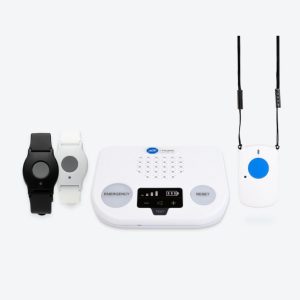

Key product features
What you should know
ADT Medical Alert Plus is a simple at-home system from an established security company. All packages include free shipping, no equipment or activation fees, and a free protection plan that covers damaged or defective equipment.
- ADT Medical Alert Plus costs $39.99/month, and fall detection is an additional $11/month.
- You can use the fall detection pendant up to 600 feet from the base unit.
- The pendant doesn’t have a two-way speaker like mobile fall detection devices, so you can only speak to the monitoring center agent if you’re near the base unit. Even if you can’t communicate with an agent during an emergency, they’ll dispatch emergency services to your location.
- False alarms can be canceled with the fall detection pendant or base unit within 20 seconds of a call.
- During testing, the pendant detected three hard falls but only one soft, slow fall.
Why we like ADT Medical Alert Plus for customer-friendly policies
The ADT Medical Alert Plus includes perks many companies offer for an extra charge. When you purchase an ADT medical alert system, you’ll receive:
- Free two-day shipping
- A lifetime protection plan that covers equipment wear and tear and manufacturing defects
- No additional equipment or activation fees
- A ForeverRate™ guarantee that keeps your monthly service fee the same even if ADT increases monthly rates
ADT also covers shipping fees if you choose to return your equipment. Many medical alert companies require customers to pay for return shipping.
Our testers found the Medical Alert Plus fall detection necklace comfortable and easy to wear. It has an adjustable lanyard and is as light as a pencil, weighing around an ounce. We like that the fall detection pendant has a user manual with clear instructions on wearing the device, canceling a false alarm, and testing the pendant monthly.
For more accurate fall detection, ADT recommends wearing the pendant at chest level and over your clothes (not tucked under). Like most medical alert companies, ADT doesn’t guarantee 100% fall detection accuracy. During our testing, the necklace detected all hard falls but detected only one soft, slow fall.
When the necklace detects a fall, the base unit announces, “Fall detected. Press and hold button to cancel.” You can cancel calls within 20 seconds of this announcement by pressing and holding the pendant’s blue button or pressing “Reset” on the base unit. The base station will announce, “Alarm canceled.” If you miss canceling your call, wait to speak with a monitoring center agent and tell them it’s a false alarm—you’ll never be penalized for false alarms. Our testers were able to cancel calls easily when testing this feature.
Related: The Best Elderly Monitoring Systems
The necklace doesn’t have a two-way speaker, so you can only speak with monitoring center agents through the base unit. It’s water-resistant, meaning you can wear the necklace in the shower but can’t submerge it in water.
ADT’s waterproof wall buttons are another form of fall detection. Unlike a fall detection pendant, you must press the button manually to connect to the monitoring center through the base unit. Wall buttons are $2.99 per month each, and you can add up to seven wall buttons to your order. We recommend placing wall buttons low to the ground in areas like the bathroom, bedroom, and near staircases as a backup option if you’re not wearing your fall detection necklace.
While the Medical Alert Plus has one of the shortest at-home ranges (600 feet) and fall detection costs more than average, we think the simple system and excellent customer policies make it a good option for at-home fall detection.
To learn more about this device, visit our comprehensive ADT medical alert review.
What customers are saying
Most online reviews refer to ADT’s home security and monitoring services. We found a few third-party reviews specifically for ADT medical alert systems.
Customers are pleased with the equipment quality, comfort, and peace of mind when purchasing the medical alert system.
“It’s an important item for those who order it,” Kurt writes on Amazon. It’s very well made and professionally boxed, and support and assistance are 5-star all the way.”
“I recently became a widow. I’m 69 and very busy. My family was worried about me and my ‘projects’ now that I’m alone. I ordered this unit, got set up with the company, and now feel safe and sound. I can confidently go on about my day and not worry about falling or getting injured with no help around. The price for the base unit was reasonable, and the monthly monitoring fee is also reasonable. I would recommend this product to anyone.”
—Lou, Amazon
Some customers had billing issues and trouble canceling their service.
“[I] bought ADT medical service for my parents last year. ADT sent out a bill for a lock box I had already paid for, “ writes Myrna on Trustpilot. “Correcting this mistake was so painful…I vowed to cancel the service after the year was up. In December, I canceled the service and returned the system days later. In January, I was sent a bill for another service. They never sent a letter confirming that they received the physical system. ADT makes it very difficult to cancel orders.
“I called today to cancel my security and medical alert accounts, and I have never been so disrespected,” says Madeline on Trustpilot. “…I was placed on hold for over fifteen minutes, so I attempted to communicate by chatting. There are no results there. I want to end my financial obligations and service for home security and medical alert.”
Specs
| Response time | 60 seconds |
| In-home range | 600 feet |
| Battery life | 24-hour backup battery |
| Starting monthly fee | $39.99 |
| Fall detection cost | $11/month |
Best fall detection device for observed range: Medical Guardian MGHome
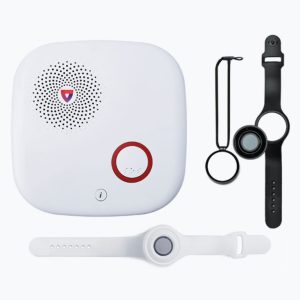

Key product features
What you should know
The Medical Guardian MGHome Cellular can respond to button pushes up to four football fields away, an impressive range for users who enjoy independence and mobility.
- We found the MGHome Cellular device lived up to its claim of detecting button pushes from a long distance away.
- Competitively priced subscription of $37.95/month. The fall detection button is also priced at an additional $10/month. However, the unit requires a one-time $149 equipment fee and $12.50 shipping.
- Best for active individuals who like to garden or spend time just outside their homes.
- Sensitive fall detection means there may be some false alarm triggers.
- Real-time location info is provided through the caregiver app.
Why we like Medical Guardian MGHome Celluar as best for observed range
The Medical Guardian MGHome Cellular is a feature-packed, home-based medical alert system with advanced technology and a user-friendly design. Its 4G LTE and WiFi connectivity ensures a fast and reliable connection to the company’s 24/7 monitoring center. It provides users with comfort, knowing that help is just a button press away.
One of the notable features of the MGHome Cellular is its impressive range. Oour testing found that the device protected up to 1,400 feet (about four football fields) between the wearable pendant and the base unit. This extensive coverage allows users to move freely in and around their homes while still being protected. The water-resistant medical alert watch and necklace can even be worn in the shower, ensuring that users are covered during one of the most common times for falls to occur.
The MGHome Cellular also boasts a unique Voice Assist technology called Smarti. Users can activate self-testing and receive spoken reports about the device’s status by pressing a button on the base unit. However, we did notice that the power button and volume adjustment button on the base unit are very similar in color, which could lead to accidental presses.
The MGHome Cellular demonstrated fast response times during our testing, with monitoring center connections ranging from 21 to 41 seconds. The fall detection feature, which can be added for an additional $10 per month, also performed well, detecting falls within seconds. It’s worth noting that the device may be sensitive to movements that mimic falls, as our tester accidentally triggered a fall alert while fidgeting with the device. However, false alarms can be easily canceled by pressing the help button.
The MGHome Cellular also offers a powerful app and online portal called MyGuardian, which enables caregivers to stay connected and informed. Through the app, caregivers can access real-time location information, set task and medication reminders, view detailed health information about the user, and even chat with other members of the user’s care circle. While these features are impressive, some of them, such as the OnGuard Alerts that notify caregivers when the user contacts the monitoring center, come at an additional cost.
What customers are saying
While many people like their MGHome Cellular system, some customers said they had difficulty discontinuing the service when they no longer needed it.
“This device is quite well monitored, which is one of the major factors influencing our choice. The other is that it works anywhere. We’ve had situations where my wife has dropped or tossed hers onto the bed, and they call immediately. With such sensitivity, I have much more confidence that this device will get help to her very quickly…we’ve had it for several years and have always been impressed with this company.”
—Cliff, Trustpilot
“I have not had to use my Guardian for an emergency, but I wear it all the time, and among my friends, I am the only one who does so,” writes E.S. on Trustpilot. “I learned from a friend who took off her Guardian and relied on her phone until the day she fell and lay on the floor for hours with her phone on the table. My necklace is always on me!”
Difficulty canceling the service was a common complaint among some reviewers.“Using the device was easy and worked well. When our mother went into a nursing home, it took me months to cancel our service,” writes Kathy on Trustpilot. “Turns out you have to sign and return a Medical Device Cease and Desist letter. Nobody told me this for several months. So, each month I would get billed again, call, and be told my account was now canceled.”
Specs
| Response time | 21-41 seconds |
| In-home range | 1,400 feet |
| Battery life | 32-hour backup |
| Starting monthly fee | $37.95/month |
| Fall detection cost | $10/month |
Best fall detection device for battery life: LifeFone VIP Active
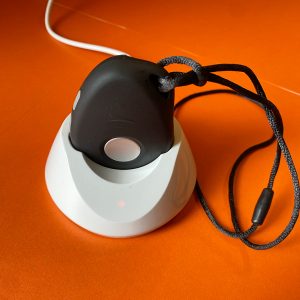

Key product features
What you should know
For users who don’t want to be bothered with constantly remembering to charge their fall detection device, we recommend LifeFone VIP Active.
- We found the LifeFone VIP Active easy to set up and use. We especially liked the long-lasting battery and low-battery reminders.
- Monthly subscription fee is $41.95, but the $5/month fall detection fee is at least half what competitors charge.
- Active individuals will especially benefit from this fall detection device.
- Offers a 30-day risk-free trial.
- Nationwide coverage through LifeFone’s AT&T plan.
Why we like LifeFone VIP Active as best battery life
The LifeFone VIP Active is a compact and feature-rich mobile medical alert system that allows users to stay protected at home and on the go. One of the most impressive aspects of this device is its long-lasting battery, which can provide up to five days of continuous use on a single charge. During our testing, we found that the VIP Active consistently delivered on its battery life claims, making it an excellent choice for those who want to minimize the hassle of frequent charging.
Setting up the VIP Active is straightforward, thanks to the clear and easy-to-follow instructions in the start-up guide. The guide features a large, readable font and includes helpful troubleshooting tips and a customer service number at the bottom of every page. We particularly appreciated the emphasis on creating an emergency care plan early in the setup process, ensuring that users have their emergency contacts in place from the start.
While the VIP Active boasts many positive attributes, a few areas could be improved. The light indicators on the device are small and difficult to see, and the charging confirmation cue can be unclear, as a fully charged device is signaled by the absence of light rather than the presence of one. Additionally, pushing the device into the charging cradle requires a fair amount of force and a distinct click to ensure a proper connection, which may be challenging for users with dexterity issues or limited strength.
“Dexterity challenges can make everyday tasks, such as buttoning clothes, using utensils, or handling small objects, increasingly difficult and frustrating. As a result, many older adults may experience a reduced ability to maintain their independence, leading to decreased self-esteem and potential social isolation. Impaired dexterity can also increase the risk of accidents and injuries, such as cuts, burns, or falls.”
—Dr. Raj Dasgupta, MD, FACP, FCCP, FAASM, Fortune Recommends Advisor
During our tests, the VIP Active’s monitoring center response times were consistently fast, ranging from 36 to 39 seconds. The fall detection feature, which can be added for an extra $5 per month, yielded mixed results. While the response times for detected falls were reliable (17-39 seconds), the device struggled to register some slow falls, particularly those from a seated position. However, when falls were successfully detected, the monitoring center agents were helpful and personable, even greeting us by name and acknowledging our ongoing testing process.
One standout feature of the LifeFone VIP Active is the ability for approved caregivers to locate their loved ones using a simple text message. This text-to-locate function provides peace of mind without navigating a complex app. The device also offers advanced location technology, utilizing cellular, WiFi, and GPS to identify the user’s location in an emergency.
To learn more, visit our full LifeFone review.
What customers are saying
Customers are pleased with how well the VIP Active system keeps up with them and their loved ones, but some say the fall detection isn’t as sensitive as they’d like.
“I did a lot of research before choosing a unit for our mother and am very pleased with the LifeFone system,” writes Billie on Trustpilot. “She is still very active and we wanted something that would be with her all the time yet not become cumbersome. We liked the VIP because she wears it as a necklace and it travels wherever she goes. We had the option of AT&T or Verizon as the carrier and also chose to have the fall protection feature. LifeFone is a little more expensive than some but the peace of mind we have is well worth it.”
“My mom used her LifeFone pendant and immediately got a response. She told the call center she was in distress. They dispatched an ambulance to her home then [called] the family. Unfortunately, each member couldn’t be spoken with directly and a message was left. The ambulance arrived, [opened] her door using the key lock door box, assisted her, and took her to the hospital. She was okay due to their quick action.”
—Teresa, Trustpilot
Some users warn of false alarms or undetected falls.
“[The] fall pendant does not always trigger emergency services,” writes Catherine on Trustpilot. “[It] seems to trigger false alarms, but on three occasions when a fall actually did occur, the fall was not detected.”
Specs
| Response time | 17-39 seconds |
| In-home range | Nationwide within AT&T or Verizon network |
| Battery life | Up to five days |
| Starting monthly fee | $41.95 |
| Fall detection cost | $5/month |
How we test fall detection devices
Fall detection devices and other medical alert systems should be reliable and helpful in emergencies. That’s why we thoroughly test and evaluate the devices to see how they hold up when it matters most. Read our full medical alert system testing methodology for more information on our testing process.
Testing criteria
Reliability and response—40%
A fast response you can rely on again and again is crucial to the performance of your fall detection device. We evaluate the following factors to provide a full picture of what you can expect from each device.
- Response time
- Signal range
- Battery life
- Water resistance
- Fall detection
Ease of use and accessibility—30%
We evaluate fall detection devices for how easy they are to wear and use, especially for those who need additional accessibility features.
- Wearability
- Voice clarity and volume
- Setup and use
- Accessibility features
Value—20%
We evaluate sticker prices, monthly fees, and add-on features to determine a fall detection device’s full value.
- Initial cost vs. ongoing fees
- Contract flexibility
- Included features vs. add-ons
- Insurance
Customer experience—10%
Shipping costs and timelines, customer support friendliness and helpfulness, and warranty timelines are factors to consider when purchasing your fall detection device. That’s why we analyze them as part of our testing process.
- Shipping
- Warranty
- Customer support
Cost of fall detection devices
The cost of fall detection devices varies depending on the features and technology incorporated into each product. (7) Basic wearable devices with simple fall detection capabilities may be included in the subscription cost or can cost as little as $20 to $50, while more advanced models with additional features like GPS tracking and automatic emergency calling can range from $100 to $300. Most devices require a monthly subscription fee for monitoring services, which can add an additional $5 to $10 or more per month. Ultimately, the cost of a fall detection device depends on the specific needs and budget of the individual user. (8)
How does fall detection work?
Fall detection devices typically use a combination of sensors, such as accelerometers and gyroscopes, to monitor the user’s movements and detect sudden changes in acceleration or orientation that may indicate a fall. When a potential fall is detected, the device analyzes the data to determine if the event meets the criteria for a genuine fall, such as a sudden impact followed by a period of inactivity. If the device confirms a fall, it may alert the user and prompt them to respond, indicating whether they need assistance. If the user does not respond within a predetermined time frame or if they confirm they need help, the device can automatically contact emergency services or designated caregivers to ensure the user receives prompt attention.
Related: How do medical alert systems work?
What to look for in a fall detection device
When choosing a fall detection device, consider factors such as accuracy, reliability, and ease of use. A device that is prone to false alarms or difficult to operate may not provide the desired level of protection. Look for devices with a good reputation for detecting falls and a low rate of false positives, as well as those with a comfortable, discreet design that can be worn easily throughout the day.
Consider the battery life and range of the device, ensuring that it can function for an adequate amount of time between charges and maintain a connection with monitoring services or emergency contacts. Finally, evaluate the device’s additional features, such as GPS tracking, waterproofing, or two-way communication capabilities, which may be important depending on the user’s lifestyle and specific needs.
FAQs
Does fall detection really work?
Yes, fall detection devices can effectively detect falls and alert emergency contacts or services when a fall occurs. However, no fall detection system is 100% accurate, and false alarms or undetected falls can occur. The effectiveness of a fall detection device depends on factors such as the quality of the sensors, the algorithms used to analyze movement data, and the proper use and wear of the device by the user.
“Fall detection devices can be beneficial for older adults who are at a higher risk of falls due to conditions such as osteoporosis, arthritis, or balance disorders. Those with chronic illnesses like Parkinson’s disease, diabetes, or cardiovascular issues, which can affect mobility and stability, may also benefit from these devices.”
—Dr. Raj Dasgupta, MD, FACP, FCCP, FAASM
Does Medicare or Medicaid cover fall detection devices?
Medicare does not typically cover fall detection devices, as they are considered preventive care or safety items rather than medically necessary treatments. (9) However, some Medicare Advantage plans offered by private insurers may provide coverage for fall detection devices as part of their expanded benefits. Medicaid coverage for fall detection devices varies by state, with some states offering coverage under certain waiver programs or as part of their home and community-based services, while others do not provide coverage for these devices.
Will fall detection devices work in the shower or bath?
Many fall detection devices are designed to be water-resistant or waterproof, allowing them to be worn in the shower or bath, where falls are more likely to occur. (10) However, it’s essential to check the specific device’s specifications to ensure it is suitable for use in wet environments. Some devices may be water-resistant but not fully waterproof, meaning they can withstand splashes but not complete submersion, so it’s crucial to understand the device’s limitations before using it in the shower or bath.
Is there a wearable fall detection device with no monthly fee?
Yes, there are wearable fall detection devices available that do not require a monthly fee. These devices typically rely on a one-time purchase price and do not include professional monitoring services or emergency response dispatch. Instead, they often use a companion app on a smartphone to alert designated contacts when a fall is detected, making them a more affordable option for those who don’t need or want the added costs of monthly monitoring fees.
Our experts
Dr. Raj Dasgupta, MD, FACP, FCCP, FAASM
Quadruple-board certified in pulmonary, sleep, internal, and critical care medicine. An active clinical researcher, Dr. Raj currently practices at the University of Southern California, where he’s been awarded the Excellence in Teaching award six years in a row. He’s also an associate professor of clinical medicine, assistant program director of the internal medicine residency program, and the associate program director of the sleep medicine fellowship at USC.
Krista Manning
Krista Manning is an accomplished medical copy editor and fact-checker who stands out in the pharmaceutical, health, and wellness domains. With a meticulous eye for detail and a command of medical language, Krista ensures the accuracy and clarity of content. Beyond her professional expertise, Krista is an advocate for mental health awareness. Recognizing the crucial intersection of psychological and physical well-being, she actively contributes to projects that promote mental health awareness within the healthcare narrative. Krista’s commitment extends beyond the pages she edits, emphasizing the holistic nature of health communication.

Jennifer Walker-Journey
Fortune Recommends Writer
About Author
Jennifer writes on a variety of topics from law, healthcare, eldercare, and pharmaceutical products to food, travel, and consumer products. Her clients include law firms, healthcare systems, financial corporations, public health entities, and digital marketing firms.
